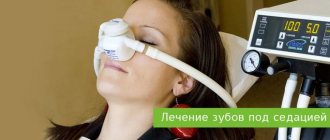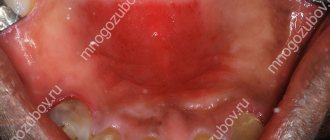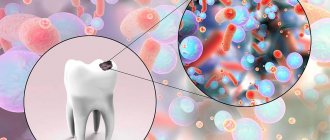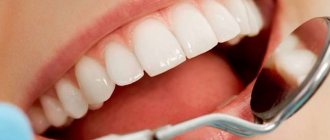First, you need to decide what anesthesia is? This is a drug due to which sensitivity in the area of the injection temporarily disappears. This process occurs by blocking nerve impulses that transmit information about irritation to the human brain, blocking the response in the form of pain. After the anesthetic wears off, the patient regains full sensation.
Even with the availability of modern medical equipment and the high quality of services provided by competent specialists, it is impossible to completely exclude painless dental treatment.
Also, the psychological aspect plays an important role. Many patients, delaying their visit to the doctor, do not fully understand the seriousness of the possible consequences. During such periods, they may be driven not so much by fear of treatment, but by the possibility of pain, which they associate with previous negative experiences. By delaying a visit to a specialist, people involuntarily allow the development of an inflammatory process in the teeth and gums, which directly affects the effectiveness of local anesthesia.
The next reason that interferes with the pain relief process is fear. Adrenaline, produced by the adrenal glands, enters the bloodstream, raising blood pressure and speeding up the heart rate. This process prevents the material from penetrating the nerve, making pain relief impossible.
What is anesthesia?
The procedure for injecting special drugs aimed at eliminating local sensitivity is called anesthesia. The active substance of the anesthetic blocks the conduction of impulses from nerve endings to the brain, preventing the occurrence of pain in response to manipulations. After the anesthetic wears off, sensitivity is completely restored.
Today in dentistry there are several types of local anesthesia. The most commonly used anesthesia is an injection into the area of one tooth. Other methods are aimed at “switching off” the nerves of several teeth at once.
The anesthesia procedure allows you to avoid discomfort during dental procedures, which is why anesthesia is used everywhere during the treatment and extraction of teeth.
Anesthesia for children during dental treatment
In pediatric dentistry, the choice of anesthetic depends on the age of the child, the characteristics of his immunity and nervous system. Sedation through a breathing mask is often used - especially at a young age, when it is still difficult to explain to a child that he needs to sit still and endure an injection with a large and scary syringe in the gum. The dosage of the sedative is designed for approximately 10-15 minutes - this time is enough to calm the child and carry out all the necessary manipulations.
General anesthesia is also used in pediatric dentistry, although it is recommended in extreme cases.
In our dentists “As-Stom” for dental treatment for children
Injection anesthesia is carried out, and if the child is afraid of an injection, application anesthesia is first applied. If necessary, to exclude an allergic reaction to an anesthetic drug, a pediatric dentist can give a referral for allergy tests.
Reasons for the lack of effect of anesthesia
- Individual features of anatomy. The effect of the local anesthetic is ensured by its injection into a specific location near the nerves. However, there are people who have a non-standard structure and arrangement of nerves. In such situations, additional injections of anesthetic solution are required in other areas.
- Local inflammatory process. In the presence of infectious inflammation in the tissues, the pH level decreases, which indicates an increase in the acidity of the environment. Under such conditions, the chemical structure of anesthetics is destroyed and their effect is neutralized. There are several solutions to this problem: preliminary therapy with antibacterial drugs or the use of alternative methods of pain relief that do not affect the area of inflammation (Gow-Gates anesthesia, intraosseous anesthesia, etc.).
- Ehlers-Danlos syndrome. This is a genetic disease that affects the condition of the skin, bone tissue and muscles. With this pathology, conventional anesthesia is not effective, and it is necessary to resort to the use of stronger drugs. In some cases, for high-quality pain relief, several injections are required at once.
- Psychological state of the patient. With dental phobia (panic fear of dental treatment), the production of anxiety hormones that interfere with the action of anesthetics increases. People with this condition are advised to take sedatives before visiting the dentist.
- Red hair color. It is known that red hair is a consequence of a mutation in the melanocortin-1 gene, a change in which also reduces the effectiveness of local anesthesia.
- Poor quality anesthetic. If the storage rules for the drug are not followed and its expiration date expires, you may not expect any effect from the administration of the anesthetic. Therefore, you should be responsible when choosing a doctor and a clinic where treatment will be carried out.
- Insufficient amount of administered drug. If the dosage is incorrectly selected, the anesthetic will not be able to work effectively.
- Wrong choice of drug for pain relief. The anesthetic should be selected by the dentist depending on the method of anesthesia and the desired result.
- Violation of the integrity of the mucous membrane at the site of injection of the anesthetic. The solution will simply flow out of the tissue without having the desired effect. This can happen if you select an injection needle incorrectly, which will injure the mucous membrane, forming a wide channel behind it.
If pain relief is repeatedly unsuccessful during treatment or tooth extraction, the dentist will be able to determine the cause of the problem and select an alternative method of anesthesia.
Anesthesia for pregnant women during dental treatment
During pregnancy and breastfeeding, the patient needs to select an anesthetic drug especially carefully. Many drugs can harm the unborn child, so in the early stages (the first two months), when the fetus is forming, it is better to refrain from visiting the dentist if an operation with anesthesia is to be performed. Also, dental operations are not performed in the last two months of pregnancy.
The optimal time for dental treatment with anesthesia is the second trimester of pregnancy. For treatment, injection anesthesia is chosen, and the injection is given very precisely, with a small amount of the drug.
During lactation, if the mother has to undergo dental treatment with anesthesia, it is recommended to temporarily transfer the child to artificial nutrition until the drug is completely eliminated from the body.
Not available for pregnant women:
- General anesthesia.
Recommendations before visiting the dentist:
- The night before your appointment, drink lemon balm or chamomile tea before bed. These natural remedies have excellent calming effects.
- If you have constant strong feelings, before each dentist appointment, it is recommended to take a course of light sedatives a week before visiting the doctor. For example, “Afobazol” and “Tenoten”, they calm the nervous system, improving well-being and relieving anxiety before dental surgery. Drugs such as valerian and motherwort are best taken in tablets: tinctures are alcohol-based, which impairs the quality of pain relief.
- For the same reason, you should not drink alcoholic beverages at least 24 hours before your dentist appointment. Alcohol is eliminated from the body within 72 hours, but the products of its metabolism remain in the body for another week. To speed up the cleansing of the body from toxic substances, it is recommended to take sorbent preparations.
- Get a good night's sleep and eat before your appointment. This way you will save yourself from additional stress, and, consequently, from unnecessary problems during dental procedures.
- Be sure to tell your dentist about any medical conditions you have and the medications you are taking! This will help the doctor choose the right method of pain relief and anesthetic. In addition, taking certain medications can greatly reduce the quality of pain relief.
The main recommendation would be a careful approach to choosing a dental clinic and doctor. After all, a competent dentist, even if difficulties arise with administering anesthesia, will be able to find the right way out of the current situation.
What is dentistry under anesthesia?
By the word “anesthesia” we are accustomed to understand a complete disconnection from reality, although in fact sedation also refers to anesthesia. When the procedure is performed under anesthesia, the central nervous system (CNS) is depressed, which allows you to “switch off” without feeling fear and pain.
Both sedation and general anesthesia are carried out under the supervision of an anesthesiologist, with constant cardiac monitoring, and have a certain list of contraindications.
Sedation
– another common type of dental anesthesia, but it affects the nervous system and control of the patient’s psycho-emotional state. A person under sedation remains conscious, but is in a state of a kind of half-sleep, relaxed and calm, his sensitivity is dulled, his emotional background increases, and the body does not react to dental operations as if it were severe stress. To immerse him in this state, a sedative is administered intravenously, and additional pain relief is performed with local anesthesia.
Interesting fact:
The first dental operation under general anesthesia was performed in 1846 by dentist T. Morton, and this was, in principle, the first operation under anesthetic. Local anesthesia began to be used in dentistry later, from 1881.
Important!
Dental procedures under general anesthesia are not carried out in all clinics: this requires additional equipment, an anesthesiologist, experience with such anesthetic drugs, and an appropriate license. At As-Stom dentistry, operations under general anesthesia are not performed!
When is it reasonable to treat teeth under anesthesia?
In modern dentistry, anesthesia is often used not only for complex and lengthy operations, but also for routine dental treatment, grinding for dentures, tooth extraction, and in pediatric dentistry. However, it makes sense to use both general anesthesia and sedation in certain cases and for certain patient conditions:
- If long-term and complex treatment is planned (removal of several teeth at a time, bone grafting operations);
- If the patient suffers from a serious form of dental phobia or dentophobia (fear of the dentist and dental instruments);
- If the patient has diseases associated with an irresistible gag reflex, involuntary nervous convulsions;
- If the patient is allergic to local anesthetic drugs.
In dentistry, patients do not remain in the hospital after general anesthesia, but may well go home after
What type of anesthesia should I choose?
Choosing an anesthesia that will work specifically for you and will be most effective for a specific treatment is the task of the dentist. To prevent him from making a mistake, you definitely need to tell him about your allergy to one or another component of the drug (if you know about it), as well as about pregnancy or lactation, if you are currently going through this period. In the case of treating a child, the doctor will certainly consult with the parents first and select a safe drug.
You can make an appointment with a dentist by phone 597-05-05
or using
the online application form
on the website.
Don't forget about our promotions and discounts on dental treatment
, and be healthy!
Is anesthesia harmful in dentistry?
Properly administered anesthesia, in which the immersion in and out of sleep is carried out by an experienced anesthesiologist, does not have any further harmful effects on the body. Contrary to terrible rumors, it does not take away 5 years of life, does not affect potency, is not addictive, and in general, modern drugs allow you to perform an operation under anesthesia with a minimum of side effects. Yes, the load on the body during general anesthesia is quite high, but in cases where anesthesia really needs to be used, it is justified.
However, discomfort after anesthesia, unfortunately, is inevitable and continues for 12-24 hours after surgery. These include:
- Nausea and vomiting. The most common effect, which is most clearly manifested in women, young people under 30 years of age, as well as non-smokers and those suffering from seasickness;
- Chills - manifested due to anesthesia, which suppresses the body’s thermoregulation and slows down metabolic processes, due to vasodilation and a decrease in pressure;
- Headache, dizziness and drowsiness, clouded consciousness and difficulty thinking - arise due to the effect on human consciousness. This is a normal reaction of the body, more pronounced in older people.
Only an anesthesiologist can tell you the exact time when the side effects of anesthesia will go away. This depends on many factors: the gender and age of the patient, the condition of his body, his height and weight, etc.










